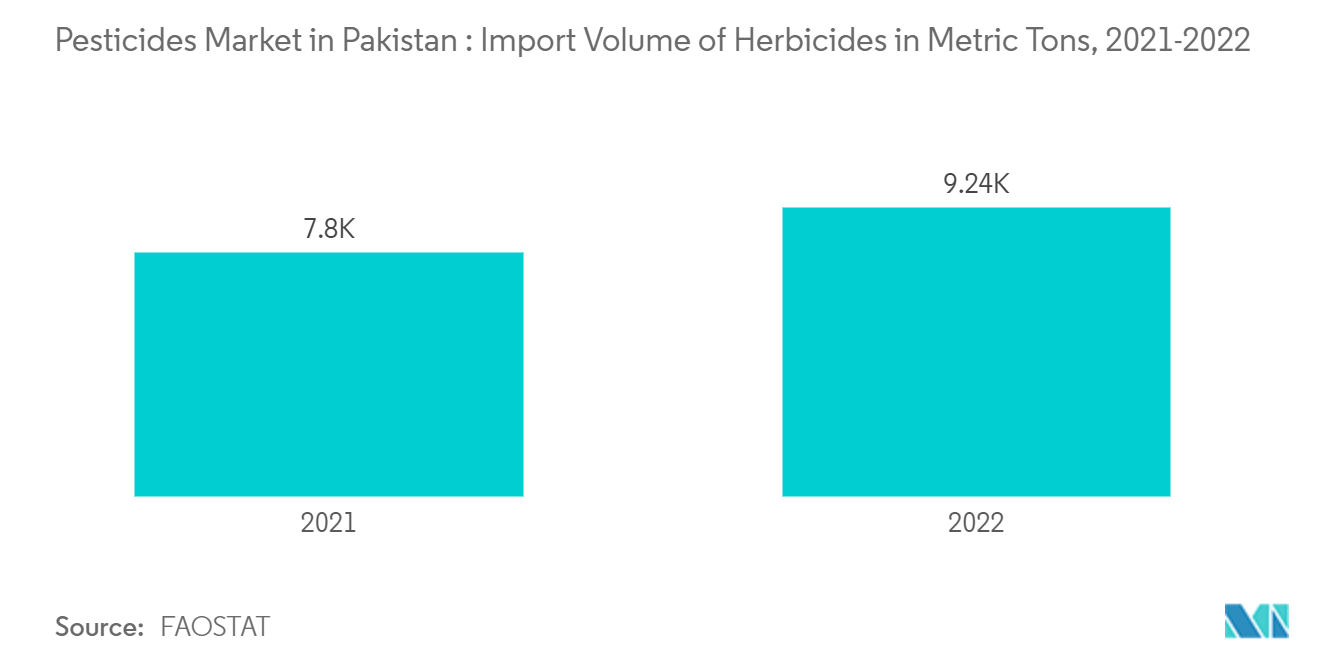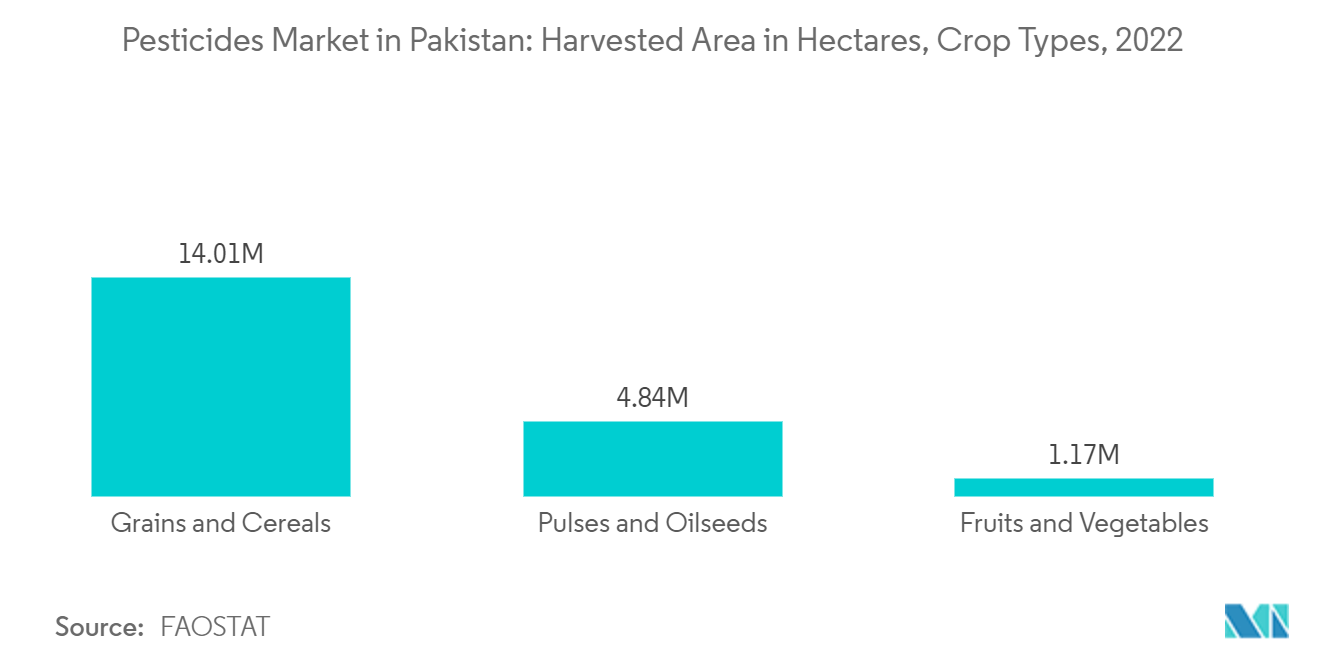Market Trends of Pakistan Agrochemicals Industry
Herbicides Dominates the Pesticide Market
Agriculture plays a crucial role in Pakistan's economic development through food production, raw material supply to industries, foreign exchange earnings, and employment generation for a majority of the population. The main food crops in Pakistan include wheat, rice, and maize, which also serve as major sources of foreign exchange. Pakistan is renowned for its high-quality "basmati rice," which is a significant agricultural export. Sugarcane cultivation is widespread in provinces like Sindh, Punjab, and Khyber Pakhtunkhwa, contributing significantly to government revenue through taxes and duties. In addition to various challenges, such as pests and climate factors, weeds significantly impact the potential yield of major crops by competing for essential resources like nutrients, moisture, and light. This competition results in reduced crop yield and compromised product quality. The demand for herbicides in Pakistan is increasing to control prevalent weeds like yellow and purple nutsedge.
Moreover, Pakistan is one of the leading producers of cotton. According to the Food and Agricultural Organization, Pakistan was ranked the sixth-largest producer and third-largest exporter of raw cotton globally in 2022, producing 2.4 million metric tons. It also has the third-largest cotton spinning capacity in Asia, with thousands of ginning and spinning units producing textile products from cotton. However, the presence of weeds in cotton plantations causes serious damage to cotton production in the country. Purple nutsedge (Cyperus rotundus) is a major weed problem in cotton fields in Pakistan and causes 62-85% yield loss. Therefore, Pakistani growers applied herbicides on cotton plants to control weeds.
Bensulide, Paraquate, Glyphosate, and Clomazone are some of the major synthetic herbicides used in Pakistan. Additionally, Clodinafop-propargyl is primarily used in wheat fields to control grass weeds like Phalaris minor. In the southern zone, where cereals and forest plantations are cultivated, 2,4-D, simazine, metsulfuron, pendimethalin, trifluralin, oxyfluorfen, fluoxypyr, and S-metolachlor are major herbicides. Thus, to eliminate the weeds from the crop and maintain the crop quality, herbicide usage has been increasing which is supporting the segment growth during the forecast period.

Grains and Cereals Lead as the Largest Growing Segment
Pakistan is one the major producers and exporters of various grains and cereal crops, including wheat, maize, barley, rice, and sorghum. The rising cultivation of these crops and infestation of weeds and diseases are driving the consumption of crop protection chemicals. According to the Food and Agriculture Organization, the total cereal production has increased by 1.04% between 2020 and 2022, reaching 47.7 million metric tons in 2022. This is mainly due to the increased usage of crop protection chemicals, which reduces the losses and increases production.
Insects such as aphids, corn borers, armyworms, grain weevils, and other insects are a major threat to grains and cereals. For instance, according to the research published in the Journal of Plant Diseases and Protection in 2022, in Sindh, Pakistan, the R-strain of the fall armyworm (FAW) has been discovered feeding on maize crops. This marks the inaugural report, backed by molecular evidence, confirming the presence of this invasive pest on maize in Sindh, Pakistan, highlighting its expanded host range. Fall armyworms have the potential to reduce corn yields by 25% if not managed timely. Insecticides such as chlorpyrifos, deltamethrin, imidacloprid, cyfluthrin, and others are used to control these pests that can cause significant yield losses.
Wheat cultivation is susceptible to various fungal diseases such as wheat blast disease, powdery mildew, smuts, rusts, fusarium head blight, tan spots, septoria leaf blotch, and other diseases that cause damage to the crop. Extreme drought and heat conditions help these diseases to grow. This led to the increased use of fungicides and their application rates thereby driving the market growth.
According to the United States Department of Agriculture, in Pakistan, Barnyard grass is known to be a highly competitive weed with cereal crops such as rice for essential resources such as water, nutrients, and sunlight. If left uncontrolled, it can significantly reduce rice yields by up to 30.0%, leading to economic losses for farmers, as it has a fast growth rate and can emerge quickly after rice planting. Hence, soil treatment of herbicides is more popular in Pakistan among farmers and is often applied before planting crops or vegetation. They can create a barrier in the soil, preventing weed seeds from germinating and thus reducing weed pressure throughout the growing season, thus making them an effective solution for the farmers.
Furthermore, nematodes pose a serious threat to cereals production in Pakistan. Nematodes, such as cereal cyst nematodes (Heterodera spp.) and root lesion nematodes (Pratylenchus spp.), are major pests that cause substantial yield losses. For instance, the re-emergence of the wheat seed gall nematode (Anguina tritici) in Punjab is notable across different wheat cultivars, with some varieties like Chakwal-50 showing higher susceptibility, which in turn increases the application of nematicides. Therefore, the increased threat from growing pest infestations and diseases is anticipated to drive market growth during the forecast period.


